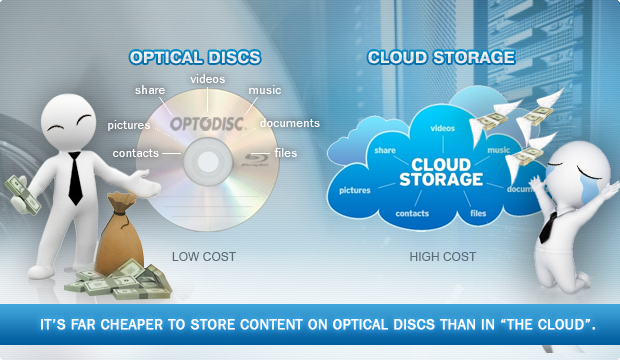Not only is an optical disc safer for your archival storage, but it’s also cheaper to maintain as well. Often people don’t think about the costs associated with storing content in “The Cloudâ€, but over time it really adds up. Yet, outside of the initial cost for the disc itself, there are no residual costs associated with storing content on optical discs. It cost nothing to store an optical disc in a drawer for safe keeping, when you need it you load it into a disc reader and view the content instantly. Yet when you store that content on “The Coudâ€, which is essentially just a server farm that a 3rd party controls, or even on your own servers, then there is a continuous cost that accumulates day after day, month after month and year after year.
Servers require a lot of electricity to operate, both to operate and maintain the server but even more so for the air conditioning that maintains the server’s temperature and protects against overheating. Even if you think The Cloud is free, once you go over the small allotment of “free†space, then many opt to pay a monthly or annual fee for greater storage capacity. It may seem fairly inexpensive in the short term, but rarely does anyone delete old content to make room for the new content, so those fees just continue to accumulate and escalate. Once you calculate those fees over the long term, then you’ll see how these small fees can really add up and the more content you store the more the cost of maintaining it increases.
Case in point, Facebook recently teamed up with Panasonic to create a whole ecosystem for offloading cold data (old content that is rarely if ever reviewed, but still needs to be available) from their servers and stored onto optical discs instead. They invested in storing content on optical discs in order to keep the content safe and easily available, while freeing up valuable storage space on their servers for new data that is more frequently accessed. This application drastically reduces the overall energy demand, saving a remarkably large amount of money. If it costs hundreds of thousands to millions of dollars to develop and implement this new cold data optical disc storage hardware and software, then you can imagine how much they must be spending on energy costs for that investment to make financial sense.
You may not be on the same level as Facebook, but the key is there are expenses that you could drastically reduce or eliminate by reducing the content stored on in The Cloud or on your own servers by placing cold data on optical discs and storing them in a safe and convenient location.
For more details on any of the products that Vinpower carries, please visit our website at www.vinpowerdigital.com or speak with an official Vinpower representative near you.

